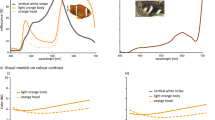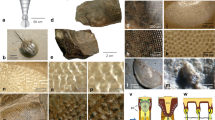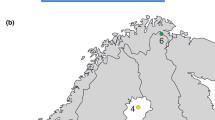Summary
In many oceanic hyperiid amphipods the eyes are double structures, with a specialized upward-pointing region covering a narrow field of view. Inter-ommatidial angles were measured across the eyes of 10 species from different depth ranges. With increasing depth (decreasing light) there is a trend towards greater dorso-ventral asymmetry resulting in the separation of the two retinae and an increase in the size of the upper eye. The diameters (D) of the dorsal ommatidia increase with depth, and the inter-ommatidial angles (Δφ) decrease. There are no corresponding changes in the lower eyes. These features can be explained on the assumption that the upper eyes are used to detect small opaque targets against the downwelling light from the surface. In contrast to the resolution of grating-like targets, where the productD Δ φ should increase as light intensity decreases (the ‘eye-parameter’; Snyder 1979), the detection of single targets requires that the ratioD/Δ φ should increase in dim light. Amongst hyperiids this ratio does indeed show a 50-fold increase from surface-to deep-living species, whereas the eye-parameter hardly changes.
Similar content being viewed by others
References
Ball EE (1977) Fine structure of the compound eyes of the midwater amphipodPhronima in relation to behaviour and habitat. Tissue Cell 9:521–536
Bowman TE, Gruner H-E (1973) The families and genera of Hyperiidea (Crustacea: Amphipoda). Smithsonian Contrib Zool 146:1–64
Chun C (1896) Atlantis. Biologische Studien über pelagische Organismen. Zoologica (Stuttgart) 7:1–260
Dietrich, W (1909) Die Facettenaugen der Dipteren. Z Wiss Zool 92:465–539
Harbison GR, Biggs DC, Madin LP (1977) The associations of Amphipoda Hyperiidea with gelatinous Zooplankton. II. Associations with Cnidaria, Ctenophora and Radiolaria. Deep Sea Res 24:465–488
Horridge GA (1978) The separation of visual axes in apposition compound eyes. Phil Trans R Soc Lond B 285:1–59
Jerlov NJ (1968) Optical oceanography. Elsevier, Amsterdam
Kirschfeld K (1974) The absolute sensitivity of lens and compound eyes. Z Naturforsch 29 c:592–596
Kirschfeld K (1979) The visual system of the fly: physiological optics and functional anatomy as related to behaviour. In: Schmitt FO, Worden FG (eds) The neurosciences 4th study program. MIT Press, Cambridge Mass, pp 297–310
Land MF (1980) Eye movements and the mechanism of vertical steering in euphausiid Crustacea. J Comp Physiol 137:255–265
Land MF (1981 a) Optics and vision in invertebrates. In: Autrum H (ed) Vision in invertebrates (Handbook of sensory physiology, vol VII/6 B). Springer, Berlin Heidelberg New York, pp 471–492
Land MF (1981 b) Optics of the eyes ofPhronima and other deep-sea amphipods. J Comp Physiol 145:209–226
Land MF (1984) Crustacea. In: Ali MA (ed) Photoreception and vision in invertebrates. Plenum, New York, pp 401–438
Land MF (1989) Variations in the structure and design of compound eyes. In: Hardie RC, Stavenga DG (eds) Facets of vision. Springer, Berlin Heidelberg New York, pp 90–111
Land MF, Burton FA, Meyer-Rochow VB (1979) The optical geometry of euphausiid eyes. J Comp Physiol 130:49–62
Madin LP, Harbison GR (1977) The association of Amphipoda Hyperiidea with gelationous Zooplankton. I. Associations with Salpidae. Deep Sea Res 24:449–463
Meyer-Rochow VB (1978) The eyes of mesopelagic crustaceans. II.Streetsia challengeri (Amphipoda). Cell Tissue Res 186:337–349
Nilsson D-E (1982) The transparent compound eye ofHyperia (Crustacea): examination with a new method for analysis of refractive index gradients. J Comp Physiol 147:339–349
Schneider L, Gogala M, Draslar K, Langer H, Schlecht P (1978) Feinstruktur und Schirmpigment-Eigenschaften der Ommatidien des Doppelauges vonAscalaphus (Insecta, Neuroptera). Cytobiologie 16:274–307
Sherk TE (1978) Development of the compound eyes of dragonflies (Odonata). III. Adult compound eyes. J Exp Zool 203:61–80
Snyder A (1979) Physics of vision in compound eyes. In: Autrum H (ed) Vision in invertebrates (Handbook of sensory physiology, vol VII/6 A). Springer, Berlin Heidelberg New York, pp 225–313
Stavenga DG (1979) Pseudopupils of compound eyes. In: Autrum H (ed) Vision in invertebrates (Handbook of sensory physiology, vol VII/6 A). Springer, Berlin Heidelberg New York, pp 357–439
Thurston MH (1976) The vertical distribution and diurnal migration of the Crustacea Amphipoda collected during the SOND cruise 1965. J Mar Biol Ass UK 56:383–470
Zeil J (1983) Sexual dimorphism in the visual system of flies: the compound eyes and neural superposition in Bibionidae (Diptera). J Comp Physiol 150:379–393
Author information
Authors and Affiliations
Rights and permissions
About this article
Cite this article
Land, M.F. The eyes of hyperiid amphipods: relations of optical structure to depth. J. Comp. Physiol. 164, 751–762 (1989). https://doi.org/10.1007/BF00616747
Accepted:
Issue Date:
DOI: https://doi.org/10.1007/BF00616747




